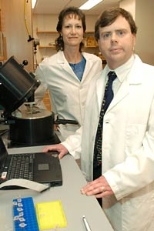LEXINGTON, Mass.--Researchers at MIT's Lincoln Laboratory and Department of Biology report in the July 11 issue of Science that they have created a fast, powerful new sensor that can identify everything from SARS to bioterrorist agents.
Called CANARY (Cellular Analysis and Notification of Antigen Risks and Yields), the sensor gives cells that comprise the body's first line of defense against viruses and bacteria the ability to glow like jellyfish in the presence of contaminants.
Todd H. Rider of the Biosensor and Molecular Technologies Group at Lincoln Lab has been working since 1997 on a bioagent detector that can pinpoint disease-causing organisms and viruses in air and water, on contaminated surfaces and in body fluids faster and with more sensitivity than conventional sensors.
CANARY has potential applications in medical diagnosis (it can detect pathogenic bacteria, viruses, fungi, protozoa and proteins from samples in a variety of formats); environmental uses (it can test water quality, indoor air quality for diseases such as Legionnaire's, food safety and agricultural pathogens such as foot-and-mouth); and defense (it can detect anthrax and other biowarfare agents).
Rider says that existing sensors are based on chemical reactions that can take several hours to work and require several thousands of particles to detect. In contrast, CANARY can detect as few as 50 colony-forming units of the plague bacterium in less than three minutes.
Especially in the case of bioterrorism, Rider said, "It's desirable to have something faster and more sensitive."
From an immunology course he had taken as an MIT graduate student in 1995, Rider knew that B lymphocytes are a type of white blood cell that our bodies use to launch a quick attack against bacterial and viral invaders. "Nature had already designed B cells to detect any bacteria and viruses very rapidly, so rather than come up with an artificial assay, I decided to go with what nature had already created," he said.
Rider created a special strain of mouse B cells and identified a jellyfish gene that allows the organism to produce a protein that glows. In a collaboration with Jianzhu Chen, associate professor of biology in the MIT Center for Cancer Research who studies the molecular mechanisms underlying the development and function of the immune system, Rider then genetically engineered B cell lines that glowed in response to specific bacteria and viruses.
The researchers generated B lymphocytes carrying the calcium-sensitive bioluminescent protein as well as antibodies specific for one or more pathogens. When the cells connect with the right pathogens, their calcium levels rise within seconds and they emit light.
In addition to creating cell lines to detect a variety of specific pathogens, including anthrax, plague, smallpox, equine encephalitis and chlamydia, a sexually transmitted disease, the Lincoln Lab engineers developed hardware to house the cells.
The cells are placed in a luminometer, a container that keeps the cells alive in a test tube and monitors their luminescence in the presence of pathogens. A laptop computer provides a readout of the cells' response.
In addition to Rider, Lincoln Lab biologists involved in producing the cell lines are Martha S. Petrovick, Frances E. Nargi, David J. Blanchard and Eric. D. Schwoebel. Lincoln Lab staff who developed the sensor hardware include Richard H. Mathews, James D. Harper and Albert M. Young.
This work is funded by the Defense Advanced Research Projects Agency and the U.S. Army Soldier and Biological Chemical Command.






